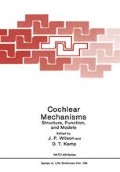Abstract
The linkages between stereovilli (stereocilia) of hair cells have been implicated both in the mechanical properties of the bundles and in the transmission of stimulus-induced movements to the individual mechanotransducer channels (e.g. Flock and Strelioff, 1984; Pickles et al., 1984; Hudspeth, 1985). Here, we describe new observations on the fine structure of the tip links between stereovilli. We also show that the spatial organization of the tip links in bundles of different conformations in a variety of species is appropriate for a role in transduction.
Access this chapter
Tax calculation will be finalised at checkout
Purchases are for personal use only
Preview
Unable to display preview. Download preview PDF.
References
Comis, S.D., Pickles, J.O. and Osborne, M.P. (1985) Osmium tetroxide postfixation in relation to the cross linkage and spatial organisation of stereocilia in the guinea-pig cochlea. J. Neurocytol. 14, 113–130.
Csukas, S.R., Rosenquiest, T.H. and Mulroy, M.J. (1987) Connections between stereocilia in auditory hair cells of the alligator lizard. Hearing Res. 30, 147–156.
Flock, A. (1965) Electron microscopic and electrophysiological studies on the lateral line canal organ. Acta Otolaryngol. Suppl. 199 1–90.
Flock, A. and Strelioff, D. (1984) Studies on hair cells in isolated coils from the guinea pig cochlea. Hearing Res. 15, 11–18.
Gleich, O. and Manley, G.A. (1988) Quantitative morphological analysis of the sensory epithelium of the starling and pigeon basilar papilla. Hearing Res., in press.
Greenwood, D.D. (1961) Critical bandwidth and the frequency coordinates of the basilar membrane. J. Acoust. Soc. Am. 33, 1344–1356.
Holton, T. and Hudspeth, A.J. (1986) The transduction channel of hair cells from the bull-frog characterized by noise analysis. J. Physiol. 375, 195–227.
Hudspeth, A.J. (1985) The cellular basis of hearing: the biophysics of hair cells. Science 230, 745–752.
Miller, M.R. (1980) The reptilian cochlear duct. In: Comparative Studies of Hearing in Vertebrates (Eds: Popper, A. N. and Fay, R. R.) Springer-Verlag, New York, Heidelberg, Berlin, pp. 169–204.
Mollenhauer, H.H. (1964) Plastic embedding mixtures for use in electron microscopy. Stain Tech. 39, 111–114.
Pickles, J.O., Comis, S.D. and Osborne, M.P. (1984) Cross-links between stereocilia in the guinea pig organ of Corti, and their possible relation to sensory transduction. Hearing Res. 15, 103–112.
Pickles, J.O., Comis, S.D. and Osborne, M.P. (1987) The effect of chronic application of kanamycin on stereocilia and their tip links in hair cells of the guinea pig cochlea. Hearing Research 29, 237–244.
Rosowski, J.J., Carney, L.H., Lynch, T.J. and Peake, W.T. (1986) The effectiveness of external and middle ears in coupling acoustic power into the cochlea. In: Peripheral Auditory Mechanisms (Eds: Allen, J.B. Hall, J.L., Hubbard, A., Neely S.T., and Tubis, A.) Springer, Berlin, pp. 3–12.
Russell, I.J. (1983) Origin of the receptor potential in inner hair cells of the mammalian cochlea — evidence for Davis’ theory. Nature 301, 334–336.
Santi, P.A. and Anderson, C.B. (1987) A newly identified surface coat on cochlear hair cells. Hearing Res. 27, 47–65.
Ulehlova, L., Voldrich, L. and Janisch, R. (1987) Correlative study of sensory cell density and cochlear length in humans. Hearing Res. 28, 149–151.
Author information
Authors and Affiliations
Editor information
Editors and Affiliations
Rights and permissions
Copyright information
© 1989 Plenum Press, New York
About this chapter
Cite this chapter
Pickles, J.O. et al. (1989). Tip-Link Organization in Relation to the Structure and Orientation of Stereovillar Bundles. In: Wilson, J.P., Kemp, D.T. (eds) Cochlear Mechanisms: Structure, Function, and Models. NATO ASI Series. Springer, Boston, MA. https://doi.org/10.1007/978-1-4684-5640-0_5
Download citation
DOI: https://doi.org/10.1007/978-1-4684-5640-0_5
Publisher Name: Springer, Boston, MA
Print ISBN: 978-1-4684-5642-4
Online ISBN: 978-1-4684-5640-0
eBook Packages: Springer Book Archive

